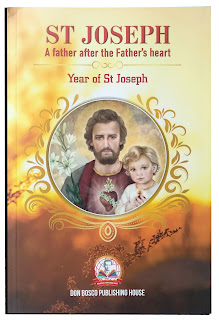Don Bosco Deeply Human Deeply Holy (Book Review)
Don Bosco Deeply
Human Deeply Holy, Peter Brocardo, translated by Abraham Kadaplackel, Don
Bosco Publications, Madras, Pp. 172.
I have read quite some books on Don Bosco but this one
appealed to me in a unique way. The book deals with the personality of Don
Bosco viewed under specific headings. Reading this book has helped me arrive at
a better understanding of Don Bosco, the man and the saint.
The author introduces Don Bosco as a saint. Firstly, he was
a saint of his times and represented what is known as “the Turin School of
Sanctity”. Secondly, he is viewed as a saint for all times. Thirdly, Don Bosco
was an active saint, meaning that, it is through work that Don Bosco found his
way to God. In him we see a splendid blending of work and prayer, which Fr
Egidio Vigano refers to as “grace of unity”.
The book is divided into two parts. The first part deals
with the ‘characteristics’ of Don Bosco while the second part deals with his
‘essential traits’. Each part consists of eight chapters and addresses a variety
of characteristics exemplified by Don Bosco. The first chapter deals with his
‘struggle to become a saint’. Don Bosco was not born a saint rather, he became
one by abandoning himself to the power of the Holy Spirit. He had a difficult
temperament and strove to control his impulses. The second chapter is entitled
‘Deeply Human’. Here we are exposed to the human qualities of Don Bosco like
his indomitable but flexible will, loving and demanding fatherliness and his
sensitivity and strength.
The third chapter displays him as a complete saint. His
sanctity is presented in two sections: Hidden and Manifest. Don Bosco’s
sanctity is hidden in as much as he never spoke about his intimate religious
sentiments. To most, he appeared an ordinary priest. Despite his attempts to
conceal his better self, sanctity penetrated the whole of his person like a ray
of light and was manifested for all to see. Cardinal Vives y Tuto, postulator
of the cause commented, “I have studied so many processes of the cause of
canonization, but have never found one where the supernatural abounds so much.”
Chapter four is titled, ‘Wonder-Worker Who Does Not Cause Fear’. Don Bosco
wielded Divine Power but remained humble. He was content to be the unworthy
instrument of God. Chapter five presents Don Bosco as a saintly founder. His
work began in difficult circumstances but guided by the Spirit and the Virgin
Mary, he pressed on with determination. All through his life he faced various
trials but he believed that God is in control and abandoned himself into His
hands.
Chapter six interestingly presents Don Bosco as a ‘shrewd
saint’. He had a reputation for being a saintly cunning priest. He advocated
shrewdness as a way of overcoming difficulties and opposition; a tool for
acquiring what one wants, not whimsically but genuinely. Shrewdness was for him
a means to sanctity. Chapter seven, ‘A Cheerful Saint’, beautifully presents
the way of life of Don Bosco. He was filled with a deep joy and spread that joy
wherever he went. He urged his boys to be cheerful and taught them how it could
help them become saints. The final chapter of the first part points out some
‘unsaintly traits’. Don Bosco was human and he too made mistakes. At times he
would exaggerate while speaking of his works and projects to impress the minds
and imagination of his hearers and win them over to his cause.
The second part gives us insight into the spirituality of
Don Bosco. The first part focused on the ‘Humanness’ of Don Bosco, the second
part focuses on his ‘Holiness’. The first chapter elaborates his motto: “Give
me souls”. It encompasses his identity and permeates his every thought, word
and deed. It reflects his preoccupation: the salvation of souls and reveals the
underlying thrust of his educative system. The second chapter is dedicated to
his ‘colossal activity’. Work was his banner. He sanctified himself through
work and much work. He made it his “mystical ladder to God”. Chapter three
deals with his prayer life. Amidst the enormous activity of Don Bosco it is
easy to lose sight of his interior life. A strong question raised during the
cause of beatification was “When did Don Bosco pray?” Facts prove that though
qualitatively and quantitatively different, the prayer of Don Bosco was not
less real and profound. It found expression in perhaps, ways that were not
conspicuous. Prayer was constant and set the tenor of his life.
Asceticism, the focus of chapter four, found place in the
life of Don Bosco. His asceticism is expressed in two inseparable words: Work
and Temperance. This is the heritage he left to his sons. All testimonies are
unanimous in saying that there were no extraordinary fasts and penances in him:
all nevertheless stress his habitual extraordinary sobriety and temperance.
Purity and continence shine remarkably in his life. Chapter five touches upon
his devotion to the Blessed Virgin. He was her ardent devotee and immortalized
his devotion and love for her through the construction of the Basillica of Mary
Help of Christians and founding the Daughters of Mary Help of Christians.
Chapter six traces the role of the theological virtues of
faith, hope and charity in the life of Don Bosco. He appeared immersed in a
network of affairs and activities, but faith was the soul of everything: he was
able to sort out the invisible in the visible, he was cooperating with the
Risen Lord for the spread of the kingdom, for the salvation of souls. Don Bosco
reveals himself a man of great hope because he was able “to hope against all
hope” to attempt the humanly impossible trusting in the power of God. He is a
great lover of God and of his neighbour in whom he saw the permanent revelation
of God. His charity is pastoral and pedagogical and finds its source in Christ,
the Good Shepherd.
The seventh chapter delineates the connection between prayer
and activity. Don Bosco’s work is apostolic, as it shares in the salvific work
of Christ. It also allowed him to access God and fostered advancement in
personal holiness. Between a pressing, charitable and humanizing apostolic
activity and prolonged prayer, the charism of Don Bosco led him to choose the
former, in which he discovered the definite will of God. The final chapter
talks about his ‘higher gifts’. The first among these is his intense pastoral
charity that enabled him to go out of himself and expend all his energy for the
good of his boys. Don Bosco also had moments of ecstasy associated with the
mystical state. In contrast to the contemplative mystics, Don Bosco is an
active mystic. It is this divine energy that flowed through him that allowed
him to go beyond his personal strength and capacity.
The book is useful for those wanting to know the person of
Don Bosco. There are many quotations and testimonies which shed light on the
various qualities being discussed. They help come to a greater appreciation of
Don Bosco and inspire reverence. It is a must read for all aspiring to become
Salesians and for those who desire to know Don Bosco, the man and the saint.



Comments
Post a Comment